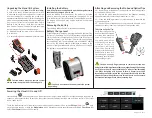
Development and manufacturing of non-
destructive testing equipment and system
Hardness tester NOVOTEST T-UD3
7
a permanent spherical indentation is produced in the surface. This
plastic deformation leads to a loss of energy of the impact body and
thus to a lower speed after the actual rebound phase.
The speed ratio is determined exactly at the moment of
impact/rebound by means of the special signal processing. The
speed ratio is therefore unaffected by the impact direction. As
opposed to this, other rebound hardness testers require presetting
of the impact direction in fixed steps (influence of gravitation on the
speed ratio) - which constitutes a considerable disadvantage with
frequently changing test positions.
5.2. UCI method
The Vickers diamond is fixed to the tip of a round metal rod. This
metal rod is excited, to its resonant frequency of approx. 78 kHz,
into longitudinal oscillations. When the Vickers diamond contacts the
sample surface, the resonant frequency will change. This change
happens in relation to the size of the indent area from the Vickers
diamond. The size, in turn, is a measure for the hardness of the
tested material. Resonant frequencies can be measured very
accurately. This is why the UCI method is suited to make the
evaluation of Vickers indents, and thus of the complete test
procedure, so much easier and quicker.
There are also two additional advantages:
- the measurement is made under load. (No impairment of the
measurement due to elastic resilience);
- the hardness measurement is based on the area of the indent and
not on the length of the indent diagonals.
The measurement is thus less affected by surface roughness; even
gunmetal-finished surfaces can be measured.
Concerning the UCI method, the measurement value is also
dependent on the Young’s modulus of the material.








































